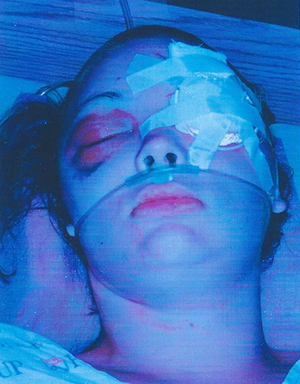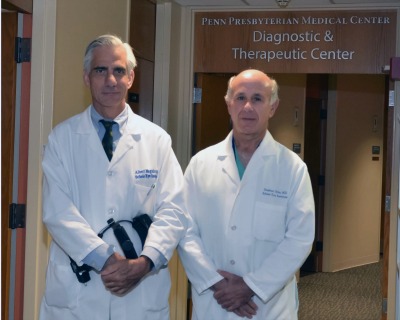Think only those who play carelessly with fireworks get injured? Meet Stacy Young. She was sitting more than 100 yards away from a firework display when she was struck in the head. Her skull was fractured in five places, she lost an eye, half her face was burned black, her hair, gone.
About 100 people had gathered in an open field bordering a state park in rural Pennsylvania for a casual, pre-Fourth of July backyard barbecue. Stacy had been sitting cross-legged on the ground, chatting with a friend reclining on a hammock strung between two trees.
The sound reached her first. “You know the sound," Stacy said. "The air-sucking sound and then the bang, and then blood-curdling screams.” At first, Stacy didn't know she had been hit. The friend she was speaking to was on fire from the debris, and was struggling to remove her shirt. Stacy screamed for water. And that’s the last thing she saw.
“Out of nowhere, my vision went completely dark, and I couldn’t see a thing,” Stacy said.
She was told she would never see again, but with the help of her ophthalmologists, physicians who specialize in medical and surgical eye care, her sight was saved – twice.
17 Years And Six Procedures
Over the next 17 years, Stacy would undergo six procedures. Surgeons used some 30 postage stamp-sized titanium plates to reconstruct her skull. A piece of her rib bone was used to recreate the bone above her left eye, but her left eye couldn’t be saved. It had to be removed and replaced with a prosthetic eye.

Stacy in the hospital after her injury
Albert M. Maguire, MD, professor of ophthalmology at the Hospital of the University of Pennsylvania and the Presbyterian Medical Center of Philadelphia, was the first to notice trouble in her right eye. The impact from the explosion affected the retina, and scar tissue was beginning to form. The retina is the light-sensitive tissue lining the back of the eye that communicates with our brain, allowing us to see. If the retina became covered with the dense tissue, she would go blind.
"Her vision was so poor that she could have literally lost her sight with a blink of the eye." – Dr. Orlin
Dr. Maguire removed the vitreous, the gel inside the eye, and carefully peeled away the scar tissue. Surgery was successful. The retina remained attached and Stacy regained useful vision.
But a few years later, she noticed her vision starting to fade again. At first, she didn’t tell anyone. Saying it out loud would make it real. Also, her insurance wouldn’t cover a visit with Dr. Maguire since he was not included in their network of physicians. Stacy trusted Dr. Maguire like no other doctor, so she waited.
When she couldn’t deny the vision loss any longer, she told her husband. Cost didn’t matter, it was time to make an appointment with Dr. Maguire.
“We have a problem.” Dr. Maguire said, minutes into the exam. “No, we don’t,” Stacy said, crying. “The last time you said that, it meant surgery.”
It did once again mean surgery. This time, cataract surgery. Stacy had developed a thick cataract that was clouding her vision. At first, Stacy resisted seeing another ophthalmologist. She only trusted Dr. Maguire. But it didn’t take long for Dr. Stephen E. Orlin to gain her trust. He yelled at her.
“That was the first time anyone hollered at me for not coming in for so long,” Stacy said. “I told him my insurance wouldn’t pay. He said he didn’t care, he told me we’ll figure it out.”
“Her vision was so poor that she could have literally lost her sight with a blink of the eye,” Dr. Orlin explained. “I reminded Stacy that for the rest of her life she would need to be under the care of an ophthalmologist.”

Dr. Maguire and Dr. Orlin.
Photo courtesy of Brian Holmes: Scheie Eye Institute
Typically, cataract surgery is not a risky procedure, but in Stacy’s case, because of the trauma she suffered and her previous retina procedure, surgery would be complicated. The cataract was partially dislocated and would require two surgeons. Dr. Maguire, the retina surgeon to remove the dislocated lens, and Dr. Orlin, the cataract surgeon, to sew in the new one.
Of all the surgeons who treated her, Drs. Maguire and Orlin were special to Stacy. They came to see her before surgery, just to check in and see if she was ready.
“They were very patient, and they never promised something they couldn’t deliver. They never lied to me. I’m grateful for that,” Stacy said. “They never promised me 20/20 or 20/400. They told me they would do what they could.”
A Life Reclaimed
They didn’t let her down. Before cataract surgery, people appeared as wooden dolls without faces. After surgery, she could see some of the letters on the reading chart. As important, she could now see faces and read emotions. She was thrilled when her husband got angry with her.
"I could actually see flowers. Not just colors but the actual petals." – Stacy Young
“Oh my god, you’re mad! You’re making angry eyes,” Stacy said, describing what it was like to see her world come back into focus after so many years of poor vision. “So, you’ve been making faces at me for 17 years!"

Stacy before and after her accident
"I had lived behind smoke," she explained. "It was strange to see things in my home that I never noticed. It’s disgusting, but it’s incredible to see dirt on the floor. I could actually see flowers. Not just colors but the actual petals.”
Despite her inspiring progress, Stacy mourns the woman she was before July 1, 2000. The independent, spontaneous woman who would drive to Atlantic City on a whim, just to put her feet in the ocean. The woman who struggled to get through college with a 1-year old son, only to graduate near the top of her class.
“She’s gone. She died on July 1,” she said. Stacy will never work as a nurse again. She could never have another child for fear that a pregnancy would cause a brain aneurysm or stroke. “I’m ok with that. I’m a better person today because I survived this. I’m humble. I feel emotion more. I know what loss is. When I say to friends, I know how you feel. Those aren’t just words to me.”
The thought of how far she has come brings her to tears. But the sound of fireworks today can bring her back to July 1, making her body shake. Stacy’s advice to those planning to bring fireworks to their next Fourth of July celebration:
“Don’t think you’re the cool person bringing the party,” she said. “Sometimes you end up ending a life.”